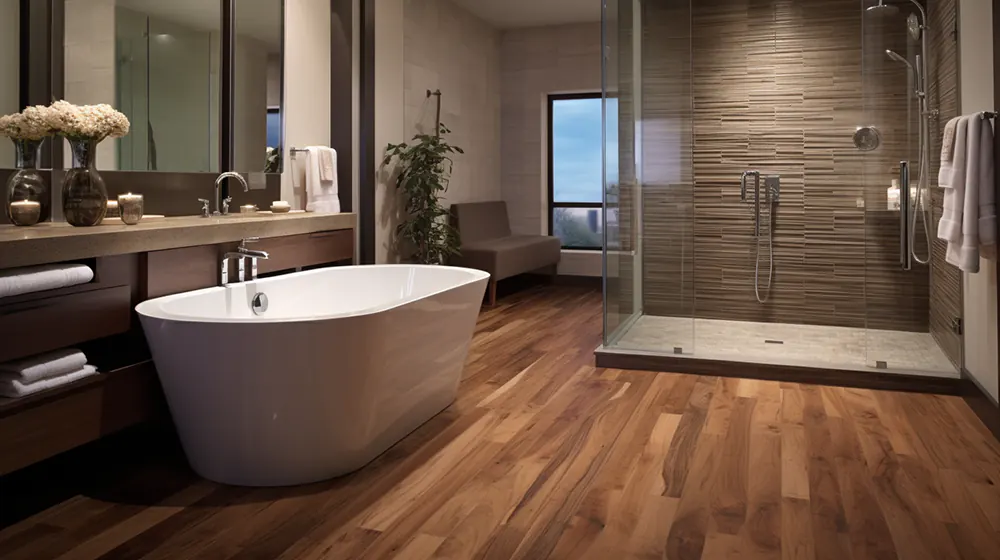Wood Floor Bathroom: Is It Better Than Tile?
Introduction
Wood flooring is a popular choice for bathrooms due to its warm, natural look and feel. Instead of the typical tile or linoleum bathroom floor, many homeowners are opting for wood flooring to create a unique and inviting space.
In this guide, we will discuss the benefits and considerations of using hardwood floors in your bathroom and powder room.
What is Hardwood Flooring?
Hardwood flooring is made from pieces of wood, typically ranging from 3/4 to 1 inch in thickness. It can come in a variety of species that can come finished or pre-finished. Hardwood flooring is known for its durability and longevity, making it a popular choice for high-traffic areas like living rooms and kitchens.
Different Types of Wooden Floors

- Solid Hardwood Flooring: This is the most traditional type of wood flooring. Solid hardwood floors are made from a single piece of wood and can be sanded and refinished many times over its life.
- Engineered Hardwood Flooring: This type of flooring is made from a thin veneer of hardwood on top of a layer of plywood. It is more moisture resistant and heat resistant compared to solid hardwood, making it a good choice for bathrooms.
- Bamboo Flooring: Although technically a grass, bamboo has characteristics similar to hardwood. It is a renewable resource, making it an environmentally friendly choice.
- Cork Flooring: This highly resilient flooring, made from the bark of the cork oak tree, is comfortable underfoot, reduces noise, and is suitable for cold water lines. However, it may be less durable than other types of wooden flooring.
Advantages of Wood Flooring In Bathrooms

Water-Resistant - Contrary to popular belief, hardwood floors can be a suitable option for bathrooms as long as it is properly maintained and sealed. With the right sealant, wood floors can resist moisture and spills, making them water-resistant.
Warmth and Comfort - Unlike tile or linoleum, which can feel cold under bare feet, wood flooring adds warmth and comfort to any bathroom. This is especially beneficial during the winter when stepping onto a cold floor can be uncomfortable. Plus, with this flooring, you won't even need to buy bath mats!
Durable - They are also known for their durability, making them a long-lasting option for your bathroom. They can withstand daily wear and tear, including high foot traffic and wet environments, making them perfect for family bathrooms.
Versatile Design - Wood flooring comes in a variety of colors, patterns, and finishes, making it easy to find the perfect fit for your bathroom's design aesthetic. From light softer woods to dark and dramatic real wood, there is a floor option for every style.
Increased Property Value - Installing wood floors in your bathroom can increase the overall value of your home. This is particularly appealing for homeowners looking to sell their property in the future.
Disadvantages of Wood Floors In Bathrooms

Prone to Water Damage - While wood flooring can be water-resistant, it is still more susceptible to water damage compared to other bathroom flooring options like tile or luxury vinyl flooring (LVP). In wet areas, it is essential to promptly clean up any spills and avoid leaving standing water on the floor.
Potential for Warping - If not properly sealed and maintained, the flooring in a bathroom can warp and become damaged. This is due to the wood allowing itself to absorb moisture or it may be a sign of bad hardwood installation if the floor started with this issue.
Higher Cost - Wood flooring tends to be more expensive than other bathroom flooring options. The cost will depend on the type of wood, installation method, and any additional sealants or finishes needed.
Considerations for Using Hardwood Floors in Bathrooms

Cost
Hardwood floors can be more expensive than other bathroom flooring options, such as tile or linoleum. Additionally, installation costs may also be higher due to the need for proper sealing and waterproofing.
Maintenance
While hardwood floors are durable, they do require regular maintenance to keep them in top condition. This includes proper cleaning and resealing every few years to prevent damage from moisture.
Potential for Water Damage
Despite being water-resistant, hardwood floors are still susceptible to water damage if not properly sealed or if spills are left unattended for extended periods. It is essential to clean up any spills immediately and regularly inspect the floor for signs of water damage.
Slippery Surface
Wooden floors can be slippery when wet, which can be a safety concern in bathrooms. To avoid potential accidents, it is recommended to place non-slip mats or rugs on the floor near tubs, showers, and sinks.
Tips for Choosing and Maintaining Wood Flooring in Bathrooms

- Choose the Right Type of Wood - Not all types of wood are suitable for bathroom use. It is essential to choose a hardwood that is naturally more water-resistant, such as teak or cedar.
- Properly Seal the Floors - Before installation, make sure your bathroom flooring is properly sealed with a waterproof sealant. Additionally, reseal the floors every few years to maintain their water-resistant properties.
- Clean Up Spills Immediately - As mentioned earlier, any type of flooring in a bathroom can be damaged by prolonged exposure to water. Be sure to clean up any spills immediately to avoid potential damage.
- Use Rugs or Mats - To prevent slips and falls, consider placing non-slip mats or rugs in the guest bathrooms. This is especially important near bathtubs, showers, and sinks.
- Regularly Inspect for Damage - To catch any potential water damage early, regularly inspect your flooring for signs of discoloration, warping, or buckling.
How to Incorporate Hardwood Flooring In Your Bathroom

- Mix and Match - If you're not ready to commit to an entire bathroom floor made of wood, consider incorporating it in smaller areas, such as a shower mat, vanity countertop, or adding ceramic tile.
- Add Accents - Another way to incorporate hardwood flooring into your bathroom is by using it as an accent. This could be in the form of a backsplash, a small section of flooring, or even a feature wall.
- Use Engineered Wood - For those who want the look of hardwood flooring but are concerned about its water resistance, consider using engineered wood. This type of wood floor is made with multiple layers and is more resistant to moisture than solid wood floors.
- Create a Warm Contrast - You could also use wood to create a warm contrast against cool-toned bathroom fixtures. For example, a rich, dark wood floor can be particularly striking against a white bathtub or sink. This contrast can add depth and interest to your bathroom, transforming it into a stylish and modern space.
Frequently Asked Questions
Can any type of wood be used for bathroom flooring?
Not all types of wood are suitable for use in bathrooms. Natural hardwoods such as teak, cedar, and oak are naturally water-resistant and can withstand the moisture levels found in bathrooms.
It is important to avoid using softwoods or untreated wood, as they are more prone to damage from water and humidity. Additionally, sealing the natural wood properly and maintaining it regularly can help prolong its lifespan in a bathroom setting.
Do I need to seal my hardwood floor in the bathroom?
Yes, it is crucial to properly seal your hardwood floor in the bathroom with a high-quality waterproof sealant. This not only protects it from moisture and water damage but also ensures its longevity and maintains its aesthetic appeal. By taking this important step, you can enjoy a beautiful and durable wood floor that adds warmth and elegance to your bathroom space for years to come.
How often do I need to reseal my wooden floor?
It is highly recommended to reseal your wooden floor every 2-3 years, or as needed, depending on the amount of foot traffic, exposure to moisture, and overall wear and tear. Regular maintenance will help protect and prolong the life of your beautiful wood floors. feel free to get a free estimate for your hardwood bathroom floor.
Additionally, proper cleaning of hardwood floors and regular inspections are crucial to ensure the longevity and durability of your floors. Remember, a little extra effort goes a long way in preserving the natural beauty and charm of your wood floors for years to come.
Conclusion

While hardwood floors may not be the most practical option for a bathroom, they can add warmth and elegance to the space. By carefully selecting the right type of wood and properly maintaining it, you can enjoy the beauty and durability of hardwood floors in your bathroom.
Just remember to take precautions such as sealing the floors, regularly inspecting for water damage, and using non-slip mats to ensure your wood flooring remains in top condition for years to come. So, if you want to add a touch of luxury and sophistication to your bathroom, consider incorporating hardwood flooring into your design.
With proper care and maintenance, it can be a stunning addition that elevates the overall aesthetic of your space. Now that you are equipped with the necessary knowledge and tips, go ahead and explore the possibility of incorporating wood flooring into your bathroom and creating a beautiful, functional, and inviting space.
If you have any other questions or concerns with your floor cleaning project do not heasatate to reach out to our flore tile specialist team. you can reach us via phone (206) 472-8573 email [email protected] or directly from our site contact page our team would love to help and suport you with your project.





